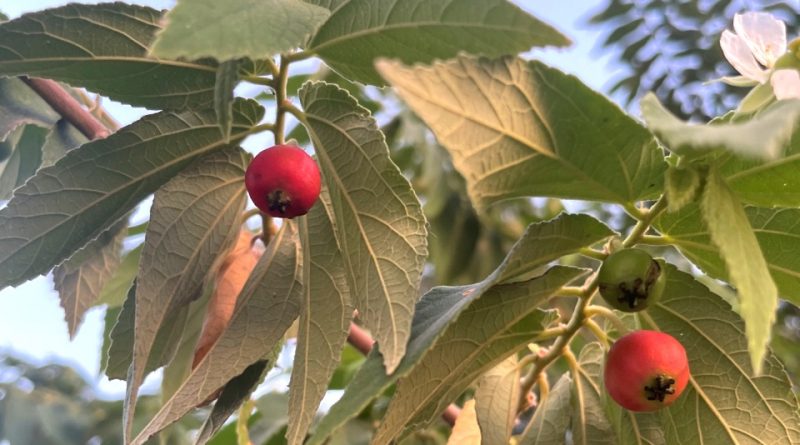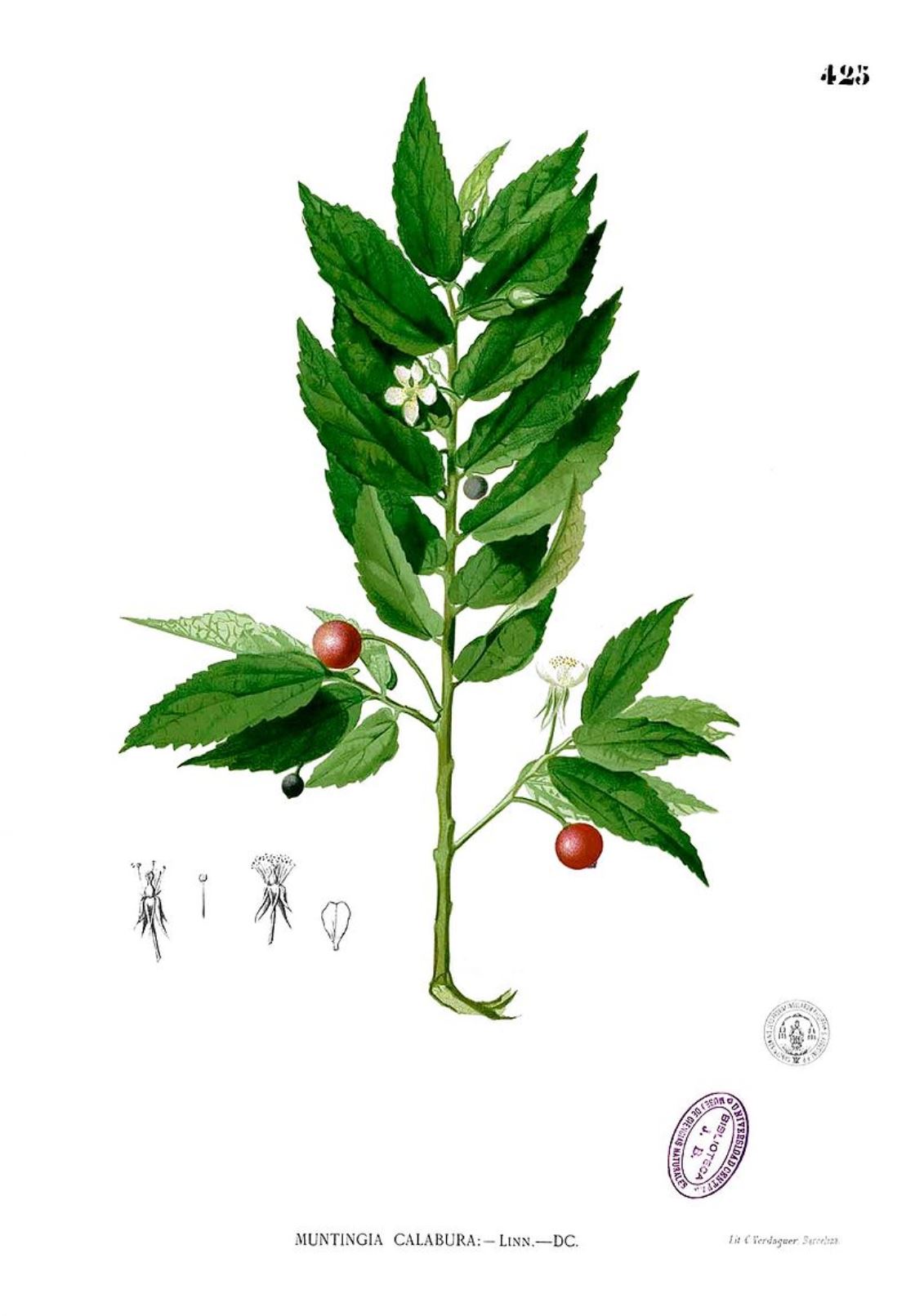Muntingia calabura
Muntingia calabura
The calabur-tree or cotton candy berry, glade mallow, glademallow, Jamaica-cherry, jam tree, manzanil, Panama-berry, Singapore cherry, sirsen, strawberry-tree (Muntingia calabura L., 1753) is an arboreal species belonging to the Muntingiaceae family.
Systematic –
From a systematic point of view it belongs to:
Eukaryota domain,
Kingdom Plantae,
Division Magnoliophyta,
Class Magnoliopsida,
Subclass Dilleniidae,
Malvales Order,
Muntingiaceae family,
Genus Muntingia,
Species M. calabura.
The terms are synonymous:
– Muntingia calabura var. trinitensis Griseb.;
– Muntingia glabra Spreng.;
– Muntingia rosea H.Karst..
Etymology –
The term Muntingia was given in honor of the Dutch physician and botanist Abraham Munting (1626-1683).
The specific epithet calabura derives from one of the common names by which the species is known locally.
Geographic Distribution and Habitat –
Muntingia calabura is a plant native to tropical America and present in an area that includes: Mexico, Belize, Costa Rica, El Salvador, Guatemala, Honduras, Nicaragua, Panama, Bahamas, Cuba, Hispaniola, Jamaica, St. Vincent and the Grenadines , Trinidad and Tobago, Bolivia, Ecuador and Peru.
Although native to tropical America it was introduced into Southeast Asia and naturalized there and in other tropical parts of the world.
Its habitat is that of the tropical climate in disturbed lowland areas from sea level to 1000 m above sea level. In southern India, it is present in areas adjacent to the Western Ghats. This species colonizes disturbed habitats in lowland tropical areas, becoming part of secondary vegetation and gallery forests. Thrives in poor soil, can tolerate acidic and alkaline conditions and drought, but does not grow in saline conditions.
Description –
Muntingia calabura is a small evergreen or deciduous tree or shrub, depending on where it grows, from 3 to 8 m (up to 12 m) tall, with a diameter of up to 20 cm, with wide, stratified foliage.
The trunk is generally cylindrical. The branches are arranged horizontally, the external bark is smooth, brownish grey, and internal fibrous, light cream coloured, astringent, with a total thickness of 3 to 7 mm.
The leaves are simple, alternate, oblong-lanceolate, 6 to 14 cm long and 2-4 cm wide, sharp, oblique at the base, with 3-5 prominent veins from the base of the leaf, with a serrated margin, of light green on the upper side and greyish green on the lower side; with pubescence of stellate hairs on both surfaces.
The flowers are white, perfect, 2 to 2.2 cm in diameter; axillary, solitary or in bundles of 1-5 flowers, although bundles of 1, 2 or 3 flowers are more common. Sepals 5, light green, 7 to 10 mm long, densely pubescent on both surfaces, valvate; petals 5, white, ovate with truncated apex, unguiculate, glabrous, with a diameter of 9 to 13 mm;
The fruit is a fleshy, multilocular, ellipsoid, juicy and sweet berry, 1 cm in diameter and dark reddish brown in colour.
Inside there are numerous tiny brown seeds weighing approximately 22.5-25.5 micrograms and 0.5 mm long.
Cultivation –
Muntingia calabura is a small, fast-growing shrub or tree that is occasionally grown for its edible fruit.
The plant flowers and bears fruit for a long period, even in young specimens. There are both red and yellow fruiting forms and it is sometimes also grown as an ornamental and service shade tree.
It is a plant of the lowland tropics, where it is found at altitudes up to 1,000 meters. It grows best in areas where annual daytime temperatures are between 70 and 90°F, but can tolerate 50-90°F.
It prefers an average annual rainfall between 1,400 and 2,000 mm, but tolerates 1,000 – 2,400 mm.
It is a plant that tolerates probably most soil types so much so that it can thrive without care in poor soil and does well in both acidic and alkaline soils and even on old barren pond soils.
However, it prefers a pH between 5.5 and 6.5, tolerating 5 – 7.
The established plants are also resistant to drought.
For cultivation the plant requires a sheltered position, the wide branches tend to break in strong winds.
Thanks to its ability to colonize disturbed soil, even on well-trodden terrain where other trees are unable to establish themselves, this tree has spread to many areas of the tropics, becoming invasive in many regions.
The seedlings bloom within two years due to their rapid growth.
Propagation occurs by seed which needs light to germinate.
The germination of fresh seeds is favored by the passage through the digestive tract of bats and birds which disperse them. The seed is well represented in forest soil seed banks and requires high temperature and light conditions for germination; among other things, the seedlings do not tolerate shade.
It can also be propagated by cuttings of semi-mature wood.
Customs and Traditions –
Muntingia calabura is a plant known by various common names; among these we report: “calabur-tree”, “cotton candy berry”, “glade mallow”, “glademallow”, “Jamaica-cherry”, “jam tree”, “manzanil”, “Panama-berry”, “Singapore cherry” , “sirsen”, “strawberry-tree” (English); “bois de soie marron”, “bois d’orme”, “bois ramier”, “cerisier de Panama” (French); “acuruco”, “bersilana”, “bolaina yamanaza”, “bolina”, “cacaniqua”, “capolin”, “capulín blanco”, “capulin de comer”, “cedrillo”, “chirriador”, “chitató”, “guácimo ”, “guinda”, “hembra”, “iumanasa”, “jonote”, “mahaujo”, “majagua”, “majagüillo”, “majagüito”, “memiso”, “memizo”, “mullacahuayo”, “nigua”, “niguito”, “niguo”, “palman”, “pasito”, “tapabotija”, “yunanasa” (Spanish); “calabura”, “pau de seda” (Portuguese); “Jamaika-kirsche”, “Panama-beere”, “Singapur-kirsche” (German); “chitato”, “majagüito”, “acuruco”, “chirriador”, “nigüito” (Ecuador); “capulín de comer” (Costa Rica); “cereza guacima” (Cuba); “zapán de comer”, “palomas antillanas”, “tomaque” (Peru).
It is a typical pioneer plant that adapts to any type of soil, even poor, and can withstand periods of drought. Parts of the plant are variously used in traditional medicine.
This plant is used both in the food and medicinal fields and for other uses.
In agroforestry use the tree has an incredible property for very rapid establishment. It is a typical pioneer species and is found colonizing disturbed sites in tropical lowlands.
Among other uses, remember that the flexible bark can be used as raw cordage.
From the bark you can obtain a resistant fibre, similar to silk, which is used to anchor supports and make ropes and is also used to make baskets.
The wood is valued in Brazil as a source of paper pulp.
The sapwood is yellowish and the heartwood is reddish-brown, solid, compact, fine-grained, moderately strong, light, internally strong and easily workable. Useful for internal coverings, making small boxes, barrels and carpentry in general.
The wood is soft and is especially valued as a fuel because it ignites quickly, burns with intense heat and emits very little smoke. It is also used as cooking wood.
Preparation Method –
Muntingia calabura is a plant used for edible and medicinal purposes, as well as a useful pioneer plant in disturbed areas.
The fruits are eaten raw or cooked. They have a sweet and juicy pulp, are excellent to eat on hand and can also be used to prepare jams, tarts, jams, etc.
The fruits are very sweet and much loved by children.
A tea is prepared from the leaves.
The infusion of the leaves is drunk as a tea-like drink.
In medicinal use the flowers are said to possess antiseptic properties.
The infusion of the flowers is appreciated as an antispasmodic. It is used to relieve headaches and the first symptoms of colds.
Guido Bissanti
Sources
– Acta Plantarum – Flora of the Italian Regions.
– Wikipedia, the free encyclopedia.
– GBIF, the Global Biodiversity Information Facility.
– Useful Tropical Plants Database.
– Conti F., Abbate G., Alessandrini A., Blasi C. (ed.), 2005. An annotated checklist of the Italian vascular flora, Palombi Editore.
– Pignatti S., 1982. Flora d’Italia, Edagricole, Bologna.
– Treben M., 2000. Health from the Lord’s Pharmacy, Advice and experiences with medicinal herbs, Ennsthaler Editore.
Photo source:
– https://inaturalist-open-data.s3.amazonaws.com/photos/342438619/original.jpg
Attention: Pharmaceutical applications and food uses are indicated for informational purposes only, they do not represent in any way a medical prescription; we therefore decline any responsibility for their use for healing, aesthetic or food purposes.


